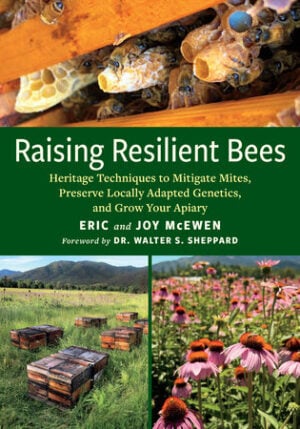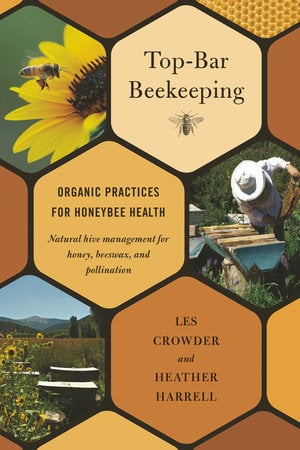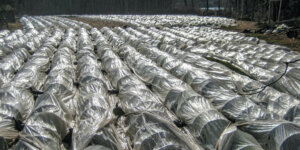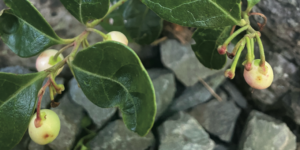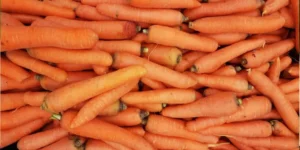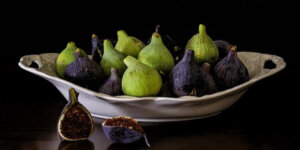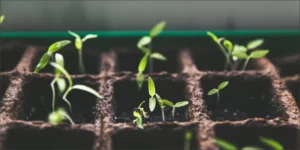How to Create the Perfect Bee Hive: A Home Worth Buzzing About
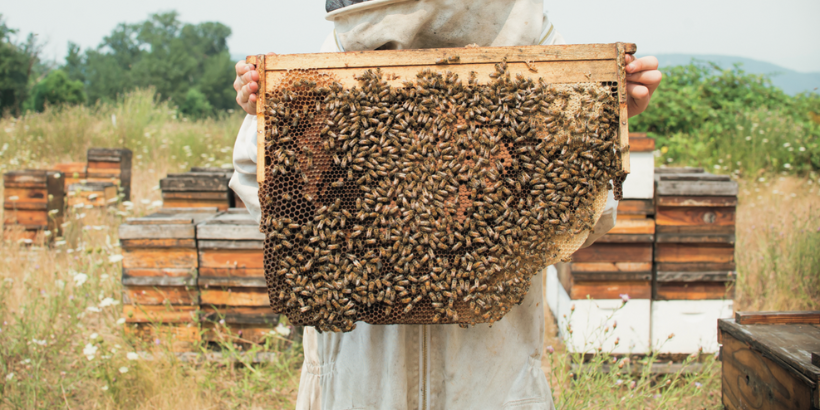
For all the beekeepers and future beekeepers out there, this one is for you! Your journey to successful beekeeping begins with constructing a suitable haven for honeybees, otherwise known as the bee hive.
The following is an excerpt from Raising Resilient Bees by Eric and Joy McEwen. It has been adapted for the web.
Bees and Humans: A Historic Partnership
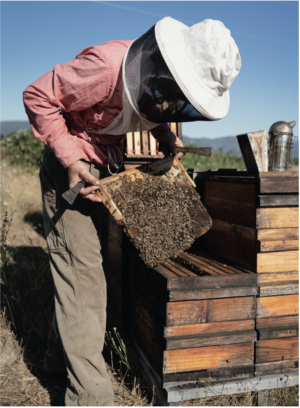
Figure 3.1. Inspecting a Natural Nest colony during the midsummer nectar flow. This is past the season of prodigious wax production. No more supers will be added to this colony, thus encouraging backfilling of portions of the brood nest with honey. Photo by Ammon Cluff
Human interactions with the honey bee date back at least 12,000 years to the earliest days of tending managed colonies.
Before this, we, like many other mammals, likely engaged in honey hunting, finding ways to subdue the fury of disturbed colonies in order to access the treasure within the cavity that acts as the bees’ larder.
A natural progression led observant humans to avoid destroying the colony during this process.
To dispatch of the colony in order to access the sweet ambrosia was to earn only a single gratifying reward; to master the art of nondestructive harvest allowed the prodigious colony to accrue ever more of this precious resource.
Around the world, wherever honey bees were to be found, human cultures were smitten with desire to associate with them and thereby share in the spoils.
Beekeeping: A Heart-Centered Hobby
As human civilizations developed, their desires slowly transformed, evoking a deep yearning to not just take from the bees but to invest our intellect in truly caring for their well-being is an insight into the true and generous nature of humans.
Creativity paired with industriousness is the apex of humanity, where well-intentioned efforts can result in a mutualistic symbiosis that benefits all parties.
Beekeeping is such a craft, when our actions remain heart centered.
We hope that this manifesto is a continuation in this lineage of well-meaning observers who desired to unlock the secrets of the bees’ ways and let their insights guide innovation for the betterment of the craft.
Honey For Shelter: An Even Exchange
Honey bees have been very patient with our experimentation through the ages, although many efforts to improve the conditions of their artificial homes have perhaps been misguided and resulted in unacceptable deficiencies, costing the bees dearly.
However, the bees have been ever present to suggest when our efforts are working in their favor and offer their sweet reward as incentive to continue our work.
Here we consider recent hive design innovations, comparing their relative merits in hopes of furthering the great debate as to the best practices for human and honey bee. In our own practice, we were compelled to take responsibility for producing the finest of bee homes for the honey bees in our charge.
By manufacturing our own hive equipment, we sought to make a quality home that meets the bees’ needs while operat- ing within the constraints of our modern society of resource scarcity.
Our Natural Nest hives embody an assemblage of hive components and features ideal for our region and the way that we keep bees. We will also speak to the lessons we’ve learned about overall apiary layout.
The Bee Hive: Creating A Home For Creatures of Nature
If the colony is a being, then the hive is the skin that envelops the being, protecting its inner workings from the harshness of the climate and the malice of intruders.
The hive should be strong enough to withstand an unforeseen blow and stable enough to resist strong winds.
It should be warm and it should be dry. As long as a colony has stockpiled adequate honey stores within the hive and maintained a healthy and robust population throughout the summer, it is prepared for winter.
The beekeeper’s responsibility—which begins long before the first flower of the season unfolds—is to ensure the hive is composed of materials suitable for the surrounding climate and the creatures housed within.
Materials for Crafting A Bee Hive
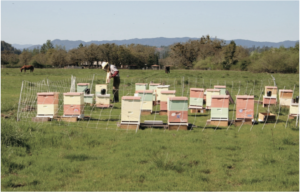
Figure 3.2. Like most beekeepers, we initially painted our woodenware with latex paint. However, it hampered our ability to hand-harvest high-quality propolis without fear of contamination from paint chips.
When considering materials for hiving bees, the environmental or carbon footprint should be of central importance.
The material and energy expenditure involved in meeting colonies’ needs must be balanced with consideration of the impermanence of these constructed homes.
For instance, Slovenian AZ hives require the construction of an entire building to house the box hives.
However this expense must be measured against the fact that this building will itself last a very long time and will likely increase the lifespan of the hive equipment, as it minimizes the exposure of woodenware to the weather.
Hives constructed of plastic, in our opinion, constitute an inappropriate use of resources, and ultimately pollute the very landscape we are trying to steward.
Likewise, log hives formed from whole tree trunk sections use large amounts of precious wood that could be used to construct more efficient hives that use less resources per colony, thereby contributing less carbon to the atmosphere over time.
Concrete & Sealants
Heavy concrete bases are even more unsustainable, concrete being a significant source of global carbon release as well as a source of soil pollution. Likewise, metal roofing, chains, and sophisticated straps with plastic components seem like poor uses of limited resources in a world of scarcity.
Our own Natural Nest beekeeping standards, which are consistent with the best available organic and biodynamic standards, use only natural materials for hive construction and colony management.
Unnatural sealants, adhesives, and glues should not be used in hive construction, as the potential for contamination is too great. Beekeep- ers must find other ways to provide adequate protection from the rains.
Any interior part of the hive should consist only of natural materials such as wood, wax, bamboo, or earth, and fasteners should be kept to a minimum.
Temperature Insulation
Hives with higher R-values (R-value being the measure of the insulative value of a material) assist the bees in keeping warm during the winter, which in turn decreases their need to consume honey stores for heat. However it is possible to create a hive that is overly insulated.
Hives insulated with foam board or insulative wraps can create such a warm environment that the bees are fooled into a higher state of activity. When they become more active inside the hive, they may rear brood and consume honey stores.
Bees in this artificially induced state of activity are at risk of consuming all their winter larder before the cold weather abates.
To achieve the right balance, it is best to create a hive that is warm, but not artificially so—unless you are keeping bees in an area with severe winters (such as frequently near 0°F [–18°C]), in which case “artificially warm” may be just enough for survival.
Managing Costs
In his informative book, Keeping Bees with a Smile, beekeeper Fedor Lazutin details the hive construction methods he found necessary to keep bees in the extreme cold and prolonged winters of central Russia.1
While the cost of materials for each of his hives is relatively high, the environmental conditions in his area are so severe that they seem warranted.
His hives include polystyrene foam boards, but they are well protected from the elements and can be used to construct new hives when the wooden components have reached the end of their lifespans.
Each beekeeper must do their own cost–benefit mathematics to determine how best to make suitable cavities for their bees. In maritime Oregon, our winters do not warrant such components, and they may even be detrimental to the honey bees in our climate.
Minimizing Moisture
While bees can handle the cold to a point, they are far more particular about moisture.
The heat required to re-evaporate water that has been absorbed by the hive interior is tremendous, and the bees must generate this heat themselves using stored honey reserves for energy, unnecessarily consuming winter stores.
This hinders spring expansion at the start of the season and ultimately limits the beekeeper’s harvest as well. Hives that minimize water absorption offer a great advantage to the colony, especially with regard to winter survival and spring build-up.
In our hive construction we use only natural materials in a natural state.
Wood, straw, and earth are all natural materials that breathe, which is an important feature of a natural cavity. The less processing, the better.
Creating A Structure: Which Wood?
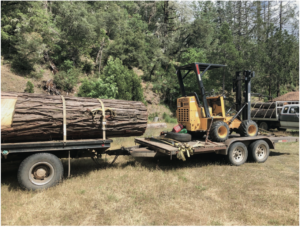
Figure 3.3. We scout out cedar and redwood, looking for sustainably harvested whole trees, and then transport them home for processing in a portable mill. This incense cedar was a standing dead tree, removed by the state highway department.
We prefer unfinished wood surfaces, which create an internal hive surface that is more familiar to the bees and encourage them to apply propolis to the hive interior, which contributes to a more mold-resistant and waterproof environment.
In particular, we prefer wood that is sourced regionally and sustainably.
For this reason—and others related to performance—we no longer use hive bodies constructed of pine milled by commercial equipment manufacturers.
This wood is undoubtedly sourced from clear-cut logging, a practice we cannot endorse for any purpose, let alone for the construction of equipment with such a finite lifespan.
We live in the region of the country where much of the nation’s wood products are produced, and we see firsthand the impacts of clear-cut logging.
Keeping Your Bee Hive Dry & Warm
We construct our hives out of highly insulative woods from the cypress family, specifically either incense cedar or coast redwood, both of which are locally abundant.
Whenever possible we source logs from standing dead trees on our farm or from nearby farms and mill them on-site with a portable band saw mill. When that isn’t possible, we work with a small, family-run mill that select-logs trees from their own land holdings.
Their practices leave behind a thriving second-growth forest with an ever-greater value, both ecologically and economically.
The growth pattern of the two aforementioned woods forms closed cells filled with air, resulting in the highest R-value of any known wood.
Compared to open-cell woods like pine, closed-cell woods not only offer greater insulation, but they are also lighter and less humid when wet because they do not readily absorb atmospheric moisture.
This makes cypress woods ideal for hive construction. Especially in colder regions with high ambient humidity, cypress hives will stay dry, tight, and light, ensuring that most of the weight of the hive is “functional weight”—bees, wax, and honey.
This will ultimately reduce the burden on the beekeeper’s back and a vehicle’s suspension when the hive needs to be moved.
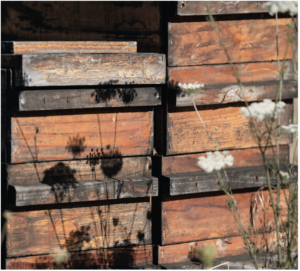
Figure 3.4. The sun casts late-afternoon shadows of Queen Anne’s lace onto a hive, which helps to guide the bees back home. Each stack of woodenware becomes a unique assemblage of patterns, lines, and colors, creating contrast and variety for the bees. This, combined with each hive’s distinct relative position upon the hive stand, keeps drift to a minimum.
Sealing the Hive From Inside
A dry hive is a warm hive. With bees helping to seal the hive from the inside, our hives can stay impeccably dry and withstand the weather for a long time. We use boards that are 7/8-inch (22 mm) thick.
We have constructed hives with boards as thick as 1 inch (2.5 cm), and while they are quality hives, any thicker than this is unnecessary and can feel like a waste of material.
Using material thicker than 1 inch may also result in R-values high enough to create artificially elevated temperatures inside the hive.
When using woods with low R-values, a slightly greater thickness is perhaps warranted. That said, the density of such woods should be assessed to consider thermal mass.
Wood with low R-value and high thermal mass will store and transmit increased amounts of cold to the interior and take longer to warm during the day, forcing the colony to expend more energy to keep warm.
Final Touches: Adding Character to Your Bee Hive
Many beekeepers use latex paint to preserve the wood and also to help the bees easily identify the hive body as home. There are many beautifully decorated and painted hives, and we feel some nostalgia thinking of beehives of old.
However, latex paint is an unnecessary and unnatural addition to the hive exterior and is a significant source of pollution in both hive products and the apiary as it flakes off onto the ground.
It is inconsistent with organic management practices, and for good reason.
We find that the bees easily identify their own hives by the unique knots, grain patterns, and color variation on natural wood, as well as the shadows of flowers cast by the afternoon sun.
We had a hard time giving up our kids’ hand-painted beehives and all the hives we named and adorned with symbols of planets, gods, and goddesses, but we know that our bees are healthier for the shift away from paint.
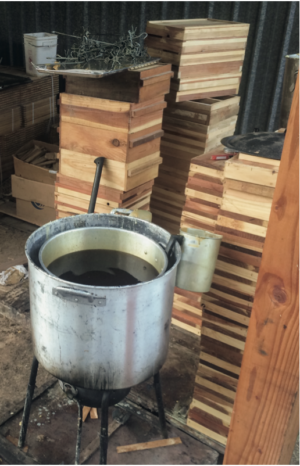
Figure 3.5. We coat our hives with a linseed oil, pine rosin, and beeswax finish. We use a double boiler to reheat the already prepared sealant.
A Simple Recipe for Coating A Bee Hive
We coat the exterior of our hive components with a mixture of linseed oil, pine rosin (as a hardener), and beeswax to extend their life in the sun and to deter water absorption. Here is our simple recipe:
Ingredients
- 2 gallons (7.6 L) raw linseed oil
- 2 pounds (.9 kg) pine rosin
- 12 pounds (5.4 kg) beeswax
Procedure
First, we boil the linseed oil. It is important to use raw linseed oil, as “boiled” linseed contains toxic petroleum products used as thinners.
Once the oil is boiling, add the pine rosin, which takes a few minutes to dissolve evenly in the oil. Add the beeswax and stir over low heat until liquified and uniform. Bring to a simmer.
Simmer for half an hour, then add the wax.
The sealant is best applied while it is hot. We use shallow, heated pans to simmer small portions of the mixture, then insert the wooden- ware directly into those pans to briefly soak, immersing only the exterior surface.
Alternatively, you can brush it on in small quantities from a pot that is kept at a simmer. This method is effective, but it’s more difficult to achieve optimal penetration without soaking.
The Finished Product: A Beautiful Bee Hive
Initially the finish is a bit oily, but after a few days of curing in the sun, the finish has further penetrated the wood and dried to a hard sheen, at which point the equipment is ready to use. We usually try to plan for about a week of sunny weather to ensure a good curing of the finish.
We have been constructing hives out of these materials for more than 8 years now. The oldest boxes in our operation have not degraded significantly and show no sign that the end of their useful life is in sight.
Because we use wood of varying quality (out of respect for the carbon footprint of our activity), we occasionally construct a hive with a board containing some soft spots or rot.
Due to these imperfections, the hive boxes occasionally give way to a chip or rotted edge. In spite of this, these boxes still provide quite well for the bees.
The bees usually make up for smaller imperfections in the wood with additions of propolis. Larger imperfections result in small, additional entrances that the bees tend to use with gusto.
We have never seen small natural openings contribute to our bees’ mortality rates to any noticeable degree.
Notes
1. Fedor Lazutin, Keeping Bees with a Smile: Principles and Practice of Natural Beekeep- ing, trans. Mark Pettus (Gabriola Island, BC: New Society Publishers, 2020).
Recommended Reads
Recent Articles
Want to grow year-round, but a greenhouse feels like a big investment? When it comes to cost and flexibility, low tunnels are the all-around winners.
Read MoreWintergreen is the stunning evergreen groundcover that’s a game-changer for your garden! It’s cherished for its aromatic leaves, vibrant fall color & bright berries.
Read MoreGrow winter carrots for a sweeter & more flavorful harvest! Ditch the bland, store-bought carrots this winter! Grow your own winter carrots for a sweeter and more flavorful twist 🥕🥕
Read MoreThe fig tree is more than just a fruit-bearing wonder. The complex nature of these trees is beyond fascinating. They are the ultimate ecosystem superheroes!
Read MoreSearching for the perfect book to give the homesteader in your life? We’ve got your go-to books for anyone interested in organic growing, permaculture, soil health, year-round growing & more! What’s their next great read?
Read More

